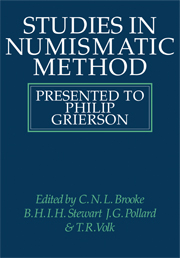Book contents
- Frontmatter
- Contents
- Acknowledgements
- Abbreviations
- Philip Grierson's contribution to numismatics
- A bibliography of the writings of Philip Grierson
- Introduction
- 1 Thoughts on the beginnings of coinage
- 2 The life of obverse dies in the Hellenistic period
- 3 Roman coinage of the Cyrenaica, first century bc to first century ad
- 4 Roman imperial coin types and the formation of public opinion
- 5 Coin hoards and Roman coinage of the third century AD
- 6 Belgian finds of late fourth-century Roman bronze
- 7 The re-use of obsolete coins: the case of Roman imperial bronzes revived in the late fifth century
- 8 Interpreting the alloy of the Merovingian silver coinagae
- 9 Carolingian gold coins from the Ilanz hoard
- 10 The novi denarii and forgery in the ninth century
- 11 On the rejection of good coin in Carolingian Europe
- 12 Ælfred the Great's abandonment of the concept of periodic recoinage
- 13 King or Queen? An eleventh-century pfennig of Duisburg
- 14 Personal names on Norman coins of the eleventh century: an hypothesis
- 15 The Gornoslav hoard, the Emperor Frederick I, and the Monastery of Bachkovo
- 16 Coinages of Barcelona (1209 to 1222): the documentary evidence
- 17 Finds of English medieval coins in Schleswig-Holstein
- 18 Privy-marking and the trial of the pyx
- 19 Judicial documents relating to coin forgery
- 20 Mint organisation in the Burgundian Netherlands in the fifteenth century
- 21 Coinage in Andrew Halyburton's Ledger
- 22 Imitation in later medieval coinage: the influence of Scottish types abroad
- 23 Barter in fifteenth-century Genoa
- Index
12 - Ælfred the Great's abandonment of the concept of periodic recoinage
Published online by Cambridge University Press: 05 May 2010
- Frontmatter
- Contents
- Acknowledgements
- Abbreviations
- Philip Grierson's contribution to numismatics
- A bibliography of the writings of Philip Grierson
- Introduction
- 1 Thoughts on the beginnings of coinage
- 2 The life of obverse dies in the Hellenistic period
- 3 Roman coinage of the Cyrenaica, first century bc to first century ad
- 4 Roman imperial coin types and the formation of public opinion
- 5 Coin hoards and Roman coinage of the third century AD
- 6 Belgian finds of late fourth-century Roman bronze
- 7 The re-use of obsolete coins: the case of Roman imperial bronzes revived in the late fifth century
- 8 Interpreting the alloy of the Merovingian silver coinagae
- 9 Carolingian gold coins from the Ilanz hoard
- 10 The novi denarii and forgery in the ninth century
- 11 On the rejection of good coin in Carolingian Europe
- 12 Ælfred the Great's abandonment of the concept of periodic recoinage
- 13 King or Queen? An eleventh-century pfennig of Duisburg
- 14 Personal names on Norman coins of the eleventh century: an hypothesis
- 15 The Gornoslav hoard, the Emperor Frederick I, and the Monastery of Bachkovo
- 16 Coinages of Barcelona (1209 to 1222): the documentary evidence
- 17 Finds of English medieval coins in Schleswig-Holstein
- 18 Privy-marking and the trial of the pyx
- 19 Judicial documents relating to coin forgery
- 20 Mint organisation in the Burgundian Netherlands in the fifteenth century
- 21 Coinage in Andrew Halyburton's Ledger
- 22 Imitation in later medieval coinage: the influence of Scottish types abroad
- 23 Barter in fifteenth-century Genoa
- Index
Summary
One has only to look at the Dorking hoard (Dolley, SCBI vm, 21) to be satisfied that towards the end of his reign Æthelwulf of Wessex (839–58), a monarch increasingly susceptible to Continental influences, standardised the type of the West Saxon penny so that henceforth all moneyers operating at any one time produced coins identical except for their reverse legends. It is clear, too, that a beginning at least was made with the withdrawal from currency of earlier issues, though obviously such policies could not be imposed on those parts of England where Æthelwulf had no jurisdiction. It is likely, too, that Danish incursions into Wessex at least as late as the 870s may further smudge the pattern where the evidence of the coin hoards as such is concerned.
Æthelwulf's ‘reform’ penny (Table 13, fig. A) appears to have been current for the first few years of the next reign, during which coins were struck with precisely the same types but substituting the name of Æthelbearht (858–66). The second of Æthelwulf's surviving sons, he either controlled or had access to mints at Canterbury, London and Rochester, and so exercised a monopoly denied to his older brother Æthelbeald, inasmuch as the Viking attack of 842 had knocked out Southampton which alone lay within the latter's share of the temporarily partitioned kingdom.
- Type
- Chapter
- Information
- Studies in Numismatic MethodPresented to Philip Grierson, pp. 153 - 160Publisher: Cambridge University PressPrint publication year: 1983
- 2
- Cited by



